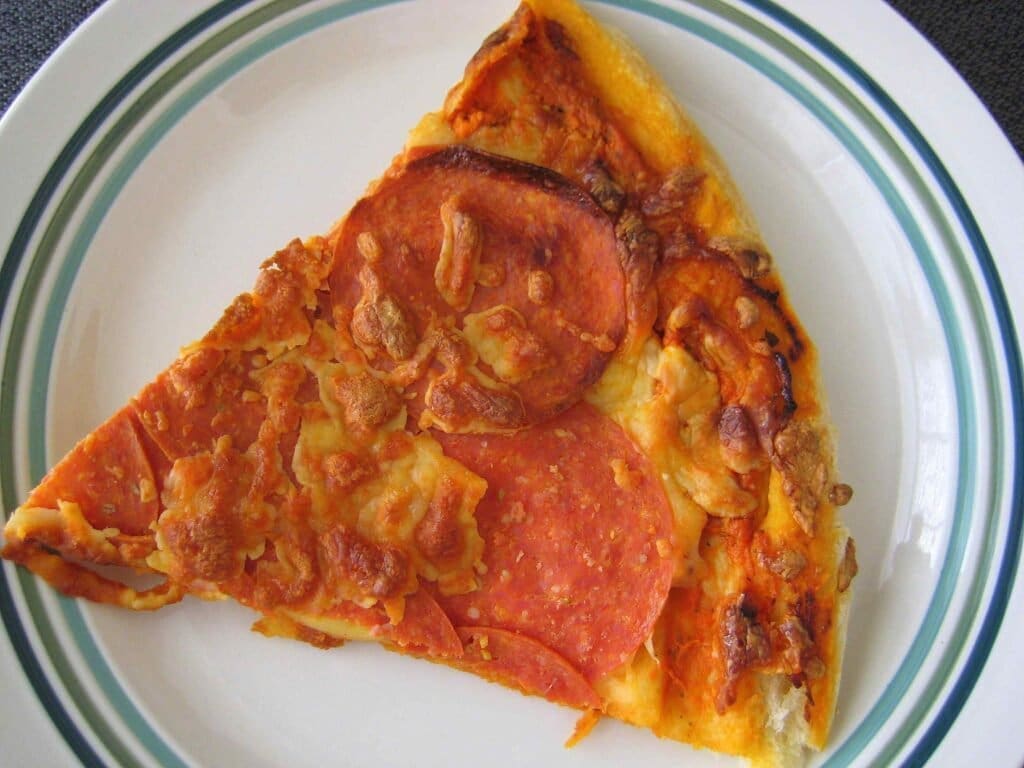It’s the weekend, and you’re too lazy to fix up something to eat. You raid the fridge and find some pizza that you’ve bought a couple of days ago. You also find yourself too lazy to get some plates and heat it up.
So the question is, “is cold pizza safe to eat straight out of the fridge?”
Cold pizza is generally safe to eat for as long as it is kept in the fridge and is kept cold for up to four days. For pizza that has been left out at room temperature, however, the general rule is that it is no longer safe to eat after two hours. Still, it is dependent on the growth of bacteria as well as the toppings used.
There are a lot of variables that come into play when considering the safety of eating cold pizza from the refrigerator or pizza that has been left out overnight.
Here, we will dive deeper and discuss if cold pizza is really bad for you.
Nutritional Value of Cold Pizza

There is not a lot of difference between eating cold and fresh pizza when it comes to nutritional values. The number of proteins, carbohydrates, fats, and other vitamins and minerals will depend on the ingredients used in the creation of the pizza as well as the size of each slice or serving.
The dough typically provides carbohydrates, while the cheese and meat toppings provide proteins. Tomato sauce and any vegetables used typically contain nutrients essential for basic body functions.
Based on the search results, here is a table summarizing the nutritional value of cold pizza:
| Nutrient | Amount per Slice |
|---|---|
| Calories | 200-340 |
| Total Fat | 10-22g |
| Saturated Fat | 5-7g |
| Cholesterol | 27-105mg |
| Sodium | 640-2100mg |
| Carbohydrates | 34-39g |
| Fiber | 2-6g |
| Sugars | 3-12g |
| Protein | 12-19g |
| Calcium | 169-750mg |
| Iron | 2.8-8.1mg |
However, pizzas can be very high in fat, especially greasy ones. It can also contain a lot of sodium and calories. In fact, a single slice of Domino’s Philly Cheese Steak Pizza can contain a whopping 1,200 calories! That’s offer half of the daily recommended caloric intake for most people.
Still, there has been some anecdotal evidence that eating cold pizza vs. fresh pizza can be a bit better for you, although this is not yet generally accepted information.
For example, cold pizza requires more energy to digest. This means that the net calories that are going into you body will be less than eating hot and fresh pizza.
This is because extra energy will be used to heat up the cold pizza during digestion. However, this difference is really not large enough to make any significant change as a weight loss strategy.
There is also some evidence that the dough in pizza becomes a form of resistant starch when kept in the cold. Resistant starch provides, among other benefits, less of a glucose spike when consumed. This makes cold pizza a better choice for diabetics or those looking out for their blood sugar levels.
Resistant starch is also good for those trying to manage their weight. However, eating in excess will still have a negative impact on the body.
Is Cold Pizza Safe to Eat?

Cold pizza that has been in the fridge for a few days is generally safe to eat. This, however, will depend on a few factors, such as how long the pizza was out before it was put in the fridge, the ingredients and toppings used, and the temperature when it was outside and when it was stored.
Bacteria such as E. coli and Staphylococcus aureus will grow on foods at temperatures between 40 to 140 degrees Fahrenheit. The USDA, in fact, recommends that pizza should no longer be consumed after exposure to this temperature range after one to two hours.
Those who consume these spoiled foods can experience cramping, nausea, vomiting, diarrhea, and other types of gastrointestinal discomfort. There may also be some fever and, in some cases, hospitalization may be required.
Pizza with toppings such as meat or vegetables as well as lots of cheese are very susceptible to these types of bacteria. As such, it is recommended that leftover pizza be stored in the refrigerator or even the freezer immediately after consumption.
Still, putting pizza in the fridge will only slow down the growth of bacteria. The best way to determine if your pizza is spoiled is by the smell test. If it smells bad, then throw it away.
Even if it does pass the smell test, always take a small bite of pizza that has been left in the fridge or outside for too long. If it has a different or unpleasant taste or texture, then discard of it immediately.
Cold Pizza vs. Fresh Pizza: Taste and Texture

There has been a lot of debate when it comes to preferences when it comes to taste and texture between cold and fresh pizza.
Proponents of the pro-cold pizza argument state that the cold cheese has a better texture and that the taste of the cheese and tomato sauce is sharper. The dough will also be a bit crunchier and sweeter if the pizza is eaten cold.
On the other hand, fresh pizza will definitely have fresher ingredients. The individual taste of each ingredient will be more prominent, and the dough will be springy and will smell great. Also, nothing says fresh than a greasy pizza with the cheese still bubbling hot enough to burn your tongue.
This is all a matter of personal taste and preference, of course, and it is only by trying both cold and fresh pizza out will you determine which one will be better for you.
How Long is Leftover Pizza Good For?

Leftover pizza is good for up to two hours if left outside, and up to four days if it has been sitting in the refrigerator. Still, this is only a rule of thumb and the time before your pizza spoils can be far longer or shorter than that.
Smell and taste are still the best determining factors to know if your cold pizza is still safe to eat. Of course, to be on the safe side, following a time-based approach is still best to ensure your safety.



